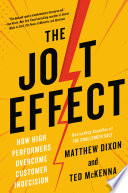

The JOLT Effect is a framework that helps individuals and organizations navigate through the unpredictability of change and disruption. It emphasizes the importance of recognizing 'jolts'—unexpected shocks or events that can drastically alter the landscape of business and personal life. The authors argue that these jolts can be both negative (like economic downturns) and positive (like technological breakthroughs), and understanding how to react to them is crucial for success. They break down the psychological and emotional responses to jolts, emphasizing that awareness and preparedness can transform potential crises into opportunities for innovation and growth.
Continue readingA key aspect of the JOLT Effect is the mindset one adopts in the face of change. The book discusses the difference between a fixed mindset and a growth mindset. A fixed mindset sees challenges as threats, while a growth mindset embraces them as opportunities for learning and development. The authors provide strategies for cultivating a growth mindset, such as reframing negative thoughts, embracing curiosity, and fostering resilience. This shift in perspective is essential for individuals and organizations to thrive amidst uncertainty, allowing them to adapt and innovate rather than retreat.
Continue readingAgility is highlighted as a vital trait for individuals and organizations to navigate the JOLT Effect effectively. The authors discuss how being agile means being able to pivot quickly in response to jolts, whether they are market shifts, technological advancements, or societal changes. They provide frameworks for building agility, such as iterative processes, cross-functional teams, and a culture that encourages experimentation. By fostering agility, organizations can not only survive jolts but also leverage them for strategic advantage.
Continue readingResilience is another cornerstone of the JOLT Effect. The authors argue that resilience is not just about bouncing back from setbacks but also about growing stronger from them. They offer practical tips for building resilience at both individual and organizational levels, including fostering strong support networks, encouraging open communication, and promoting a healthy work-life balance. By embedding resilience into the organizational culture, companies can better withstand shocks and emerge more robust and innovative.
Continue readingIn the context of the JOLT Effect, technology plays a dual role as both a source of jolts and a tool for navigating them. The authors emphasize the need for individuals and organizations to stay abreast of technological trends and to be proactive in adopting new technologies that can enhance their agility and resilience. They discuss various technologies that can facilitate change, such as artificial intelligence, big data analytics, and cloud computing. The key is to view technology not just as a tool but as a strategic partner in navigating the complexities of modern business.
Continue readingThe JOLT Effect also stresses the importance of fostering a culture of innovation within organizations. The authors argue that innovation is not just the responsibility of a dedicated team but should be ingrained in the company’s DNA. They provide strategies for encouraging creativity and experimentation, such as establishing safe spaces for brainstorming, rewarding risk-taking, and promoting collaboration across departments. By nurturing a culture that values innovation, organizations can better adapt to jolts and seize new opportunities.
Continue readingFinally, the book delves into the importance of strategic decision-making in the face of jolts. The authors outline a framework for making informed decisions during uncertain times, which includes gathering data, analyzing trends, and considering multiple scenarios. They emphasize the need for a balanced approach that combines analytical thinking with intuition and experience. Effective decision-making can mean the difference between thriving and merely surviving in a rapidly changing environment.
Continue reading